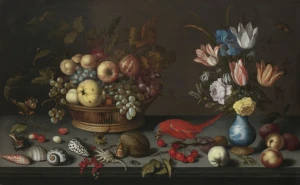Corresponding with an age of exploration, colonialism, and the rise of the great European trading companies—including the West African slave trade—intense interest in natural history and attempts to classify and categorize it grew as specimens of plants, insects, shells, mammals, and birds were collected from around the world and brought back to Europe. In particular, ornithology, the study of birds and their classification, made great strides in the 1700s with many lavishly illustrated studies of birds being published during the century. But naturalists were not the only ones fascinated by these “exotic” birds. Monarchs and aristocrats collected them in cabinets of curiosities and menageries, artists painted them, moralizers found symbolic meaning in them, and women wore their feathers as accessories. This exhibition highlights images of exotic birds in art primarily from the 17th and 18th centuries that show how they became the objects of scientific inquiry, of popular interest, of status, and even of household decoration and personal adornment.
The exhibition will showcase the Museum’s recent acquisition of the important six-volume Ornithologie written by Mathurin-Jacques Brisson and illustrated by François-Nicolas Martinet, published 1760. It will also feature paintings, prints, and decorative arts from TMA’s collection, as well as select loans of significant prints and illustrated books from the Yale Center for British Art, the University of Michigan Museums Library and Special Collections, and the Bowling Green State University Libraries Center for Archival Collections.
Learn more about Rare and Wonderous Birds through our Google Arts and Culture page here.
Sponsors
Rare and Wondrous: Birds in Art and Culture 1620-1820 is sponsored by 2021 Exhibition Program sponsors Taylor Cadillac and ProMedica with support from the McLoughlin Family Foundation and the Ohio Arts Council.










